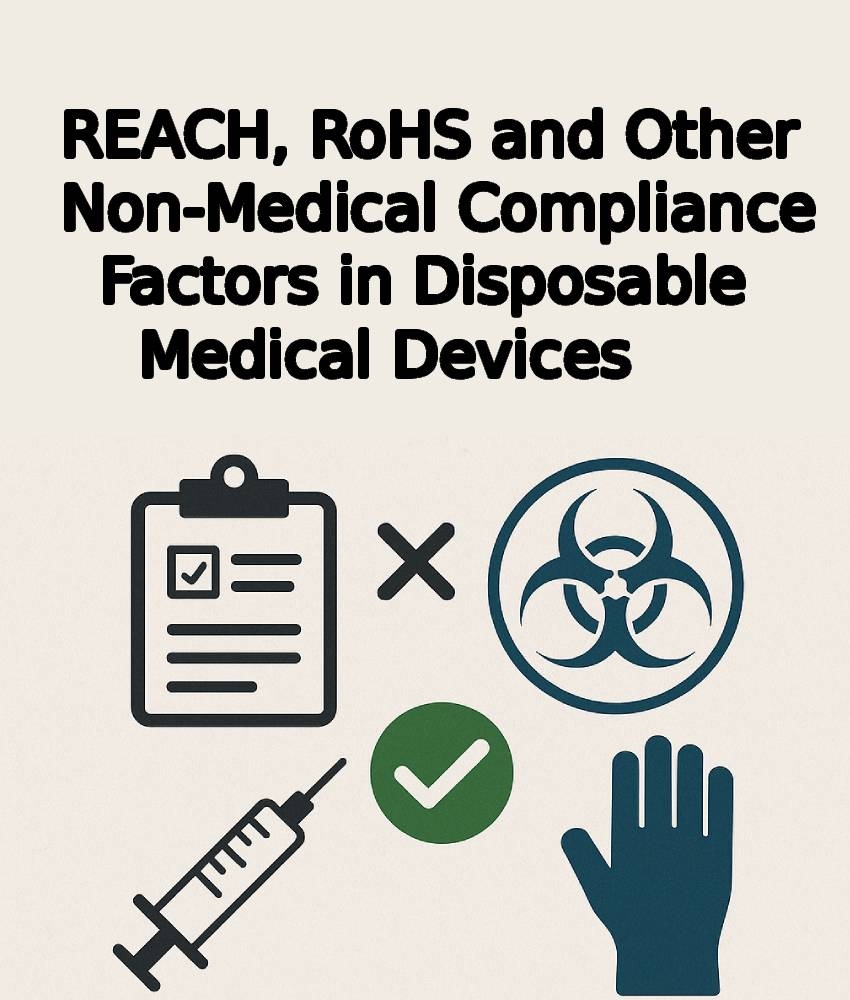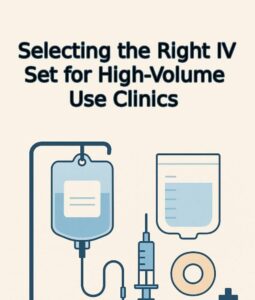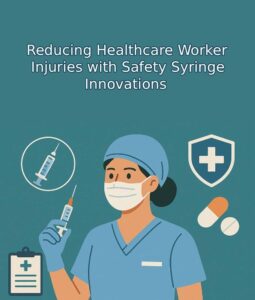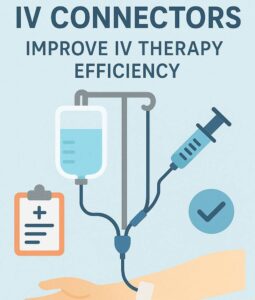When developing, sourcing, or distributing Disposable Medical Devices, many manufacturers focus solely on FDA or CE medical compliance. But in today’s global market, that’s not enough. REACH RoHS devices, non-medical regulations, and chemical compliance obligations are equally essential—especially when your devices touch both medical and industrial environments or cross borders into strict regulatory zones like the EU.
Ignoring these layers of compliance can stop a product at customs, result in financial penalties, or compromise your brand’s sustainability credentials. This article breaks down how to manage REACH RoHS devices, why non-medical regulations matter for medical products, and how to tackle chemical compliance proactively. Know more..
What Are REACH and RoHS?
To understand why this matters for your business, let’s define the two major regulations.
REACH (Registration, Evaluation, Authorisation and Restriction of Chemicals)
REACH is a European Union regulation that addresses the production and use of chemical substances. It applies to manufacturers, importers, and downstream users—whether or not they operate in the chemical industry.
Key takeaway: If your product includes any substance of very high concern (SVHC) above a set threshold, you’re required to declare it, document safe usage, and possibly find safer alternatives.
RoHS (Restriction of Hazardous Substances)
RoHS originated in the EU and restricts the use of specific hazardous materials found in electrical and electronic products. If your medical device includes electronics—like smart syringes, RFID-enabled caps, or embedded sensors—RoHS applies.
Common restricted substances under RoHS:
- Lead (Pb)
- Mercury (Hg)
- Cadmium (Cd)
- Hexavalent chromium (Cr6+)
- Polybrominated biphenyls (PBB)
- Polybrominated diphenyl ethers (PBDE)
Together, REACH RoHS devices represent a major compliance challenge—especially for companies entering European, UK, or other tightly regulated markets.
Why Non-Medical Regulations Impact Medical Products
It’s a misconception that medical compliance automatically covers non-medical regulations. In reality, most disposable medical products are also regulated under environmental, chemical, or consumer protection laws.
Here’s why non-medical regulations matter:
- Packaging: Many medical products use plastics or films that fall under REACH due to chemical additives.
- Manufacturing equipment: Machines used in production may need RoHS compliance.
- Dual-use products: Devices used in both clinical and industrial settings often fall under additional oversight.
- Custom components: If you use an electronic chip or coating agent, it may bring new chemical compliance obligations.
Non-compliance can lead to blocked shipments, product recalls, or fines—even if the product is FDA- or CE-cleared.
Key Differences Between Medical and Non-Medical Compliance
| Medical Compliance | Non-Medical Compliance |
| Focuses on safety, efficacy, and intended use | Focuses on environmental, occupational, and chemical safety |
| Overseen by FDA (USA), EMA (EU), or similar | Overseen by ECHA (REACH), WEEE, EPA, OSHA, etc. |
| Applies to the function of the product | Applies to materials, chemicals, packaging, and waste handling |
| Product-specific | Supply chain and substance-specific |
Ignoring REACH RoHS devices obligations just because a product is “medical” is a major risk.
Common Chemical Compliance Pitfalls in Disposable Devices
Whether you’re launching a sterile syringe, IV bag, or diagnostic strip, many disposable device makers face these common errors:
1. Plasticizers and Additives
Many soft plastics used in tubes or seals contain phthalates or bisphenols. These are restricted under chemical compliance frameworks like REACH and Prop 65.
2. Flame Retardants
If your packaging includes flame-retardant plastics (e.g. for transport trays), check for brominated compounds banned under RoHS.
3. Heavy Metals in Inks
Labeling ink used for branding or instruction printing might contain cadmium or lead-based pigments. These are RoHS violations.
4. Non-Transparent Supply Chains
If your components come from a third-party vendor, you’re still legally responsible for compliance. Unknown inputs = unknown risk.
How to Ensure REACH and RoHS Compliance
- Map Your Bill of Materials
Start by identifying every material, chemical, and process used in production. Flag those likely to fall under chemical compliance rules. - Request Supplier Declarations
Ask all component suppliers to provide REACH and RoHS compliance certificates or material safety data sheets (MSDS). - Use a Restricted Substance List (RSL)
Maintain an internal database of banned or restricted substances. If a new substance is added to the REACH SVHC list, your team will know. - Conduct Laboratory Testing
Especially important if you lack documentation. XRF (X-ray fluorescence) and GC-MS are common tests to check RoHS and REACH compliance. - Stay Updated
Regulations evolve. REACH adds new SVHCs twice per year. RoHS exemptions can expire. Assign someone to monitor updates.
What is Chemical Compliance, Really?
In the context of REACH RoHS devices, chemical compliance means adhering to all laws governing the use, labeling, handling, and disposal of chemicals. This includes:
- EU REACH
- US TSCA (Toxic Substances Control Act)
- China RoHS
- California Prop 65
- Global GHS labeling
Chemical compliance isn’t just for “chemical companies.” If you manufacture, import, or sell devices made from plastic, rubber, metal, or electronics—you’re in it too.
Non-Medical Regulations to Watch
Aside from REACH and RoHS, here are other non-medical regulations that may affect your disposable medical devices:
1. WEEE (Waste Electrical and Electronic Equipment)
Applies if your device contains electronics or batteries. You must take back and safely dispose of products.
2. Packaging and Labeling Laws
Some markets require recyclable or minimal-impact packaging. Others regulate the content of inks or adhesives used in printing.
3. Prop 65 (California)
Requires clear labeling if your product exposes users to substances on the state’s carcinogen or reproductive toxin list.
4. Conflict Minerals
Applies if your device includes metals like tin, tungsten, or gold. You must verify sourcing doesn’t fund conflict regions.
All of these are non-medical regulations with real consequences for your business.
REACH and RoHS for OEMs and Private Label Brands
If you’re white-labeling or distributing under an OEM agreement, your name may be on the product—but you’re still on the hook for chemical compliance.
Tips for OEM/Private Label Management:
- Require full material disclosures from partners.
- Include REACH/RoHS language in contracts.
- Retest private-labeled products periodically.
- Audit overseas factories—especially in high-risk regions.
Well-documented REACH RoHS devices compliance gives your brand a competitive edge and peace of mind.
Sustainability and ESG Considerations
In today’s world, chemical compliance isn’t just about legality—it’s about brand responsibility and sustainability.
Buyers, investors, and regulators are all asking:
- Is your packaging recyclable?
- Are your components free from known toxins?
- Do you use sustainable materials?
- Can your products be safely disposed of?
Being proactive on REACH RoHS devices and non-medical regulations shows that your brand takes ESG seriously—and that builds trust.
Building a Compliance Workflow
Here’s how successful companies manage chemical compliance:
| Step | Action |
| 1 | Assign a compliance lead or team |
| 2 | Map materials and supply chains |
| 3 | Maintain a Restricted Substances List |
| 4 | Test high-risk components |
| 5 | Document everything—keep digital records |
| 6 | Monitor regulatory updates quarterly |
| 7 | Train teams annually on new regulations |
Make compliance part of your product development lifecycle, not a last-minute scramble.
Final Thoughts: Don’t Let Non-Medical Compliance Be an Afterthought
REACH RoHS devices, non-medical regulations, and chemical compliance aren’t optional—they’re essential. Whether you’re a startup launching a new disposable product or a global brand expanding into the EU, your compliance strategy must go beyond clinical testing.
Here’s the reality:
- Medical approval won’t save a non-compliant product at customs.
- Non-compliance can stop your product from ever reaching patients.
- Full transparency and proactive planning give you an edge in safety, sustainability, and global scalability.
Quick Recap – Your Compliance Checklist
✅ Map every component and material
✅ Know which non-medical regulations apply to your product
✅ Demand documentation for REACH RoHS devices
✅ Test where needed
✅ Maintain digital compliance files
✅ Train your team
✅ Stay current—laws evolve fast
Need Help with REACH, RoHS or Chemical Compliance?
Let our regulatory experts walk you through risk assessments, testing procedures, and how to future-proof your devices from day one. We help you build safer, smarter, globally compliant products that scale with confidence.
Contact us today to discuss your product’s compliance strategy.






